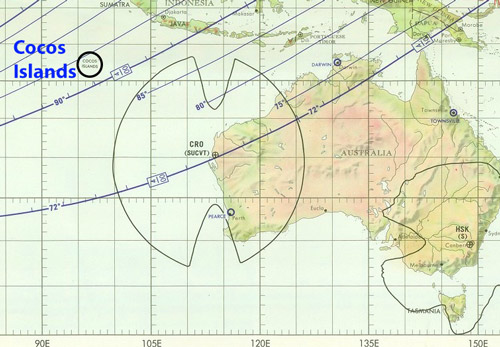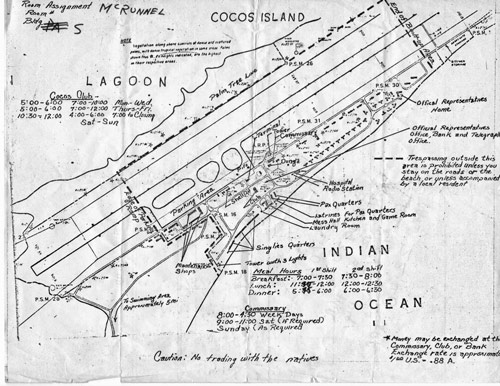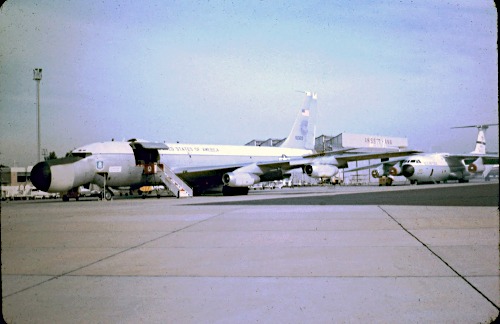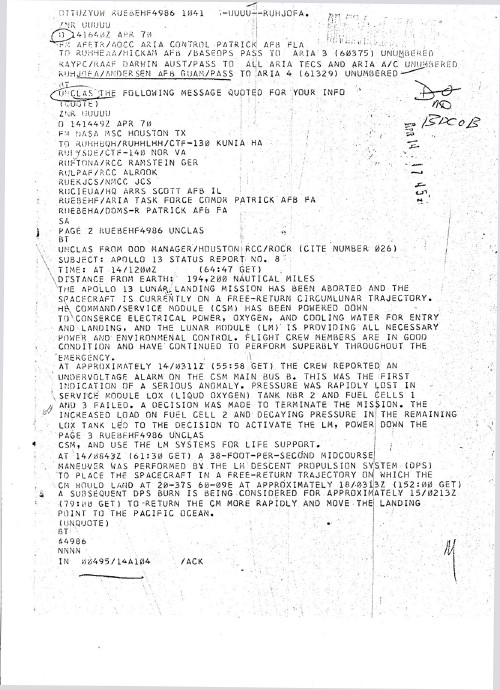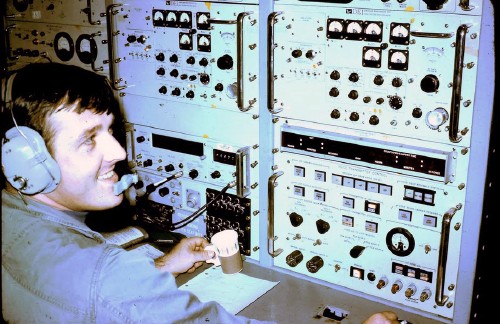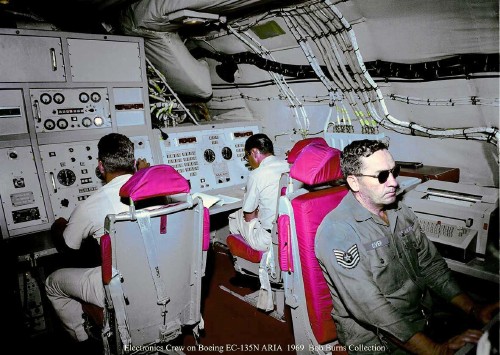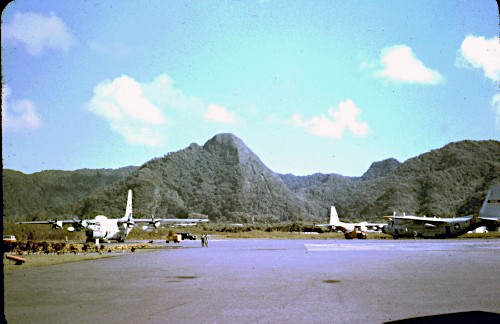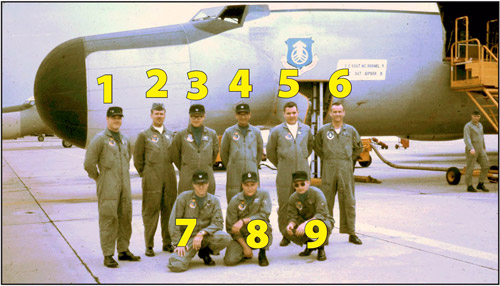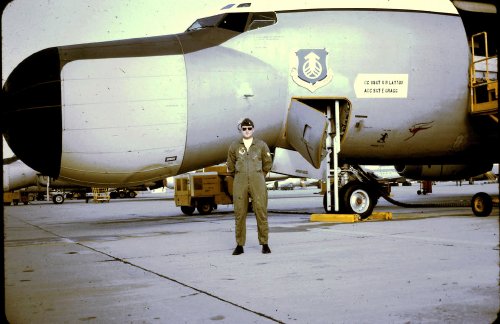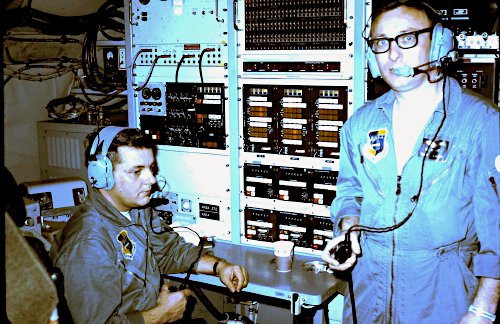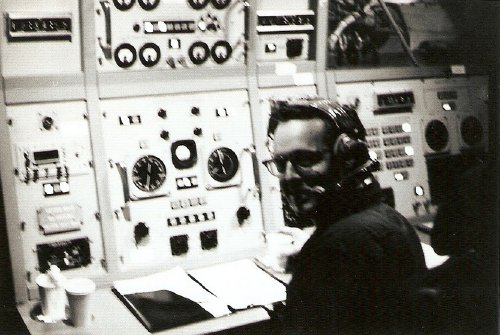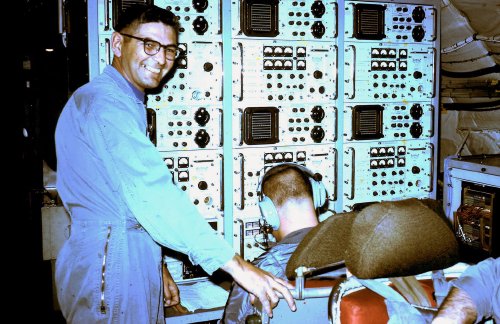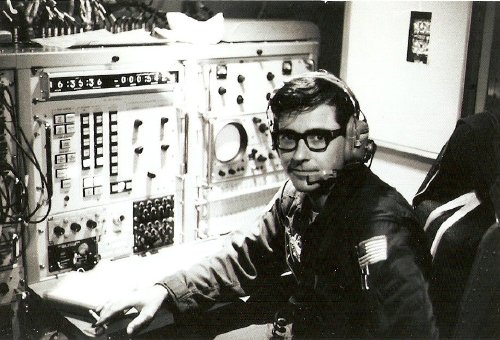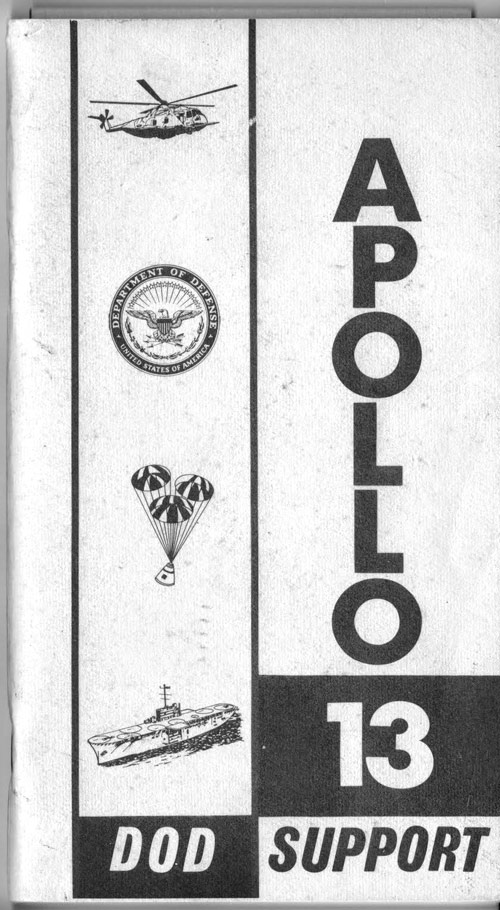ARIA 4 (Tail number 329) had the distinction of being the first to reacquire Apollo 13 after the longer-than-expected ionisation blackout.
Read the story below – and hear the onboard audio recording, courtesy of Captain Dunn.
Captain David Dunn served as the Mission Co-ordinator onboard ARIA 4.
|
ARIA 4 and Apollo 13 – by David Dunn:
Apollo 13 was launched from Cape Kennedy, Florida on April 11th, 1970 with the intent of landing a lunar module with two Astronauts on the moon and returning safely to a splashdown in the South Pacific Ocean.
The world knows well what happened to the astronauts from accounts of the time – and then from the dramatic motion picture treatment of those events. But the movie, for some reason, neglected to document what was, for a measurable portion of the world’s population, the most dramatic moment of the mission and the crisis faced by the Astronauts – the moments just prior to the time when the Apollo 13 Command Module separated from its wounded Support Module and the rescuing lifeboat of the Lunar Module and reentered the earth’s atmosphere to land in the South Pacific Ocean.
The question on all minds at the time – would they survive reentry and return alive?
It’s most difficult to realize that it has been 40 years since those dramatic moments, but for those of us who participated – the events are etched in our memories. When I purchased a tape of the movie Apollo 13, the gal at the checkout counter told me I would enjoy it. I told her I knew I would, because I was there. She told me, “Yes, my mother watched it on TV.” “No, that’s not what I mean, I was There, circling overhead at 30,000 feet watching and listening”, boy was I disappointed when I watched the movie and the part that meant the most to me was missing – the breathless moments of the reentry and recovery.
So return with me now to those thrilling days of yesteryear and I will tell you the Rest of the Story!
And if you wish, you also will find here a link to the real-time audio recording of these events that I made at the time – heard here for the first time in 40 years!
For four years, all through the Apollo land-a-man-on-the-moon program, I was stationed at Patrick Air Force Base in Florida, just south of Cape Kennedy and Cape Canaveral where I was assigned as a Mission Coordinator aboard aircraft especially equipped with electronic and radio equipment for support of the Apollo Space Program.
Eight of these specially equipped C-135 aircraft – the military version of the Boeing 707 – bristled with millions of dollars of electronics including a bulbous nose fairing that covered a 7 foot parabolic dish antenna – giving the aircraft a unique appearance that earned it the unofficial designation of the “droop snoot” or “hog nose” air force – officially the “ARIA” for Apollo Range Instrumented Aircraft.
These aircraft were designed to provide two way communication between the Apollo Spacecraft and the Houston Space Center during the crucial phase of the mission when the Spacecraft had just been launched, was in earth orbit and preparing for the rocket motor burn that would transfer the spacecraft from earth orbit to a course that would take the astronauts to the moon. Ground stations providing the same relay of communications were too far apart to provide continuous coverage – so the ARIA were literally flying ground stations that could be positioned out over the ocean to fill the gaps between ground stations.
The ARIA had no role providing communications once the Apollo was on its way to the moon and until it returned, but when the spacecraft returned the ARIA aircraft flew below the area where the capsule was planned to reenter the atmosphere and splash down in the ocean. The ARIA tracked the reentry while providing communications relay of the recovery back to Houston. This all seems nearly unimaginable today in an age of satellite communications and cell phones, but for us we were state-of-the-art.
____________________________
Just before the launch of Apollo 13, ARIA 4 deployed from our home base at Patrick Air Force Base in Florida to Cocos Island, a remote outpost in the Indian Ocean with just a sliver of land big enough for a runway that the ARIA aircraft could use. (This small atoll is literally the opposite end of the world – located all by itself in the ocean west of Australia.)
Cocos Island location map. |
We arrived on a fine sunny morning, were greeted by the local dignitaries with modest fanfare, and settled into our quarters with expectations of enjoying our stay on the tropical beaches since our schedule provided for 48 hours before we were to support the launch of Apollo 13. We had just settled in and were looking forward to exploring this unspoiled tropical paradise when we were called to pack up and return to our airplane – there was a tropical typhoon on its way to us and we had to evacuate.
This hand-drawn map of Cocos Island is packed with useful information for visiting US aircrew. Preserved and scanned by David Dunn. |
By the time we were back in our aircraft and had taxied in place for takeoff, there were driving rains, brutal crosswinds and over 4 inches of water on the runway. As we accelerated down the runway, the wheels began to hydroplane in the standing water – keeping us from accelerating to a safe takeoff speed. With runway running out, we just barely staggered off the runway and the crosswinds viciously yanked the aircraft to the port side – one of the most dangerous moments of my flying career – but we made it and headed to Perth, Australia.
ARIA 4, tail number 329 and “a C-141 transport that carried our spare parts, support equipment and additional maintenance crews” at Perth, in Western Australia, while supporting another Apollo mission. Photo: David Dunn. |
When Apollo 13 was launched in the afternoon of April 11th, 1970 in Florida, 3 ARIA aircraft were waiting in Australia – two positioned to stage from Darwin and one in Perth.
As Apollo 13 passed over Perth on the first orbit, we had just had sunset and it passed directly overhead, illuminated by the setting sun. We had just barely arrived from our harrowing departure from Cocos Island, and were just settling into our hotel rooms. From the balcony of my hotel room I had a ringside seat to watch Apollo 13 pass overhead – spectacular.
The next morning after Apollo 13 departed earth orbit for the moon, we bundled up and headed to the airport to fly to Guam and we then were scheduled to continue on to Hawaii and sit there for five days and wait for Apollo 13 to return from the planned landing on the moon.
Upon landing in Guam, we headed to our quarters. Just as we were unpacking – first word came to us of the accident onboard Apollo 13. We were recalled to our airplanes with orders to proceed to the island of Fiji to get into position to support the unscheduled return landing of Apollo 13 – even though we were in the space program, we were out of touch by radio – so while the rest of the world knew about the difficulties of Apollo 13 – we were the last to know.
Telex to the deployed ARIA, with the latest on the mission. |
On the fateful day Apollo 13 was scheduled to return, three ARIA aircraft deployed from Fiji in support of the splashdown and recovery of the Apollo 13 mission.
ARIA 2 with Captain Doug Williams as the MC was prime to support the reentry and was positioned up-track from the expected splashdown location in case the spacecraft reentry occurred earlier than planned.
ARIA 3 with Captain Jack Lennox as MC was backup to ARIA 2.
ARIA 4 had the distinction of being third in line as backup to ARIA 2 and 3, (a selection in part resulting from earlier history going back to Apollo 9, but that’s a story for later.)
As to the positions of the ARIA aircraft as I recall:
ARIA 2 was positioned to track Apollo 13 if it reentered earlier than planned – I would guess roughly 300 NM west of the planned splashdown.
ARIA 3 and 4 flew their final runs starting approximately 100 NM East of the planned splashdown point and completing their runs at a TSP (test support position) 10 NM short of spashdown and 10 NM off of the projected ground track of Apollo 13.(ARIA 2 and 3 departed the area immediately after splashdown and ARIA 4 orbited the recovery area at 31,000 feet until the Apollo crew was on the Iwo Jima.)
All three supporting ARIA aircraft arrived at the recovery area where the recovery ship Iwo Jima, a helicopter carrier ship, was waiting to pick up the spacecraft and crew.
Word came to us that the Apollo crew had jettisoned the LM, the Lunar Module that we later learned was so critical to their survival, and the Service Module that had been the source of their difficulty.
Then we heard of the loss of radio and tracking contact with the ground stations in Australia as the spacecraft began its reentry into the atmosphere and also as it began the period of radio blackout caused by the buildup of superheated plasma around the spacecraft from friction with the atmosphere.
The greatest concerns were for the condition of the Command Module – had the heat shield that protected the crew during reentry been damaged by the explosion in the Service Module? If not, then they might be burned up as they reentered the atmosphere. And, had they saved enough electrical power in the spacecraft batteries to fire the charges needed to deploy the drogue chutes?
So there we were listening and watching at the moment when tension was at its peak. Our HF radio circuits were set, our brand new satellite radio circuits set, and our antennas scanning as we anxiously searched for a signal from the Apollo spacecraft to let us know they had survived reentry.
It required no great imagination to know that back in the US, and in fact all around the world, folks were glued to their TV sets in anticipation, and that Walter Cronkite was holding forth with Wally Schirra on CBS, and at the Houston Space Center breathing had ceased.
But we were there, ground zero, with front row seats and we would be the first to know and the first ones to tell the rest of the world if the Apollo 13 crew had survived.
On all the aircraft and all the airwaves there was complete silence as well as we all listened intently for any signal from Apollo 13.
ARIA 2 had no report of contact; ARIA 3 also had no report.
Then I observed a signal and Jack Homan, the voice radio operator advised me we had contact.
Sgt Jack Homan, Voice Radios Operator. Photo: David Dunn. |
This was my moment in the limelight as I then reported to the AOCC and to the rest of the world “ARIA 4 has AOS. ARIA 4 is GO FOR REMOTE”.
And I directed Sgt Oliver, the HF Operator to connect our ground radio circuits to our spacecraft communications radios for a relay of voice traffic between Apollo 13 and the Houston Space Center.
Sgt Virgil Oliver, at right, at the HF Operator’s position onboard another ARIA at Patrick Air Force Base, Florida, 1969. In the centre is the MC (Mission Co-ordinator) console (with a stand in for this photo) and at left is the Antenna Console, from which the 7 foot parabolic antenna in the nose was controlled. Photo: Bob Burns. |
From the Cape Kennedy Cape Comtech, Dominic Mancini, came the call: “ARIA 4, you are hot to the net!”, meaning that our communications link went direct to the Houston Space Center.
From the Houston Space Center came that faithful call, “Aquarius, this is Houston, standing by” a call relayed from Houston through our ARIA radios up to the Apollo 13 spacecraft.
From Apollo 13 came the reply “OK, Joe……” relayed again from our radios to Houston and the rest of the world.
Not much, but even such a terse reply was enough to let the world know the spacecraft, and its crew, had survived.
In an age before satellite TV, teleconferencing, and the Internet, it was easy for us in the clouds at 30,000 feet above the splashdown zone to visualize breathing resuming in Houston and around the world.
Now, exactly why would Ron Howard leave such a dramatic moment out of his film? There’s a real mystery.
From that point forward, our coverage became rather routine as ARIA 4 began circling overhead the recovery area and provided continuous radio coverage of communications of all the action as the Apollo 13 crew reported deployment of the spacecraft drogue chutes, as the Navy folks visually sighted the spacecraft, as the spacecraft splashed down in the water, and as the support helicopters and swimmers secured the spacecraft and brought the crew safely back to the recovery ship standing by.
ARIAs 2 and 3 were released and headed to the airfield at Pago, Pago on the island of American Samoa.
When all the Astronauts were safely plucked from their spacecraft in the ocean and helicoptered back to the deck of the Iwo Jima, ARIA 4 was released and headed for Pago, Pago.
Some of the Recovery forces at Pago Pago. Photo: David Dunn. |
And so in just a few minutes of time the whole purpose that NASA had for supporting the ARIA program was more than justified.
The ARIA aircraft provided support for all of the Apollo launches beginning with the first manned launch, Apollo 7. And the ARIA also covered countless missile and unmanned spacecraft launches for many years until their retirement.
The ARIA 4 PMEE (Prime Mission Electronic Equipment) crew – Crew B-15, over a four year period flew the most ARIA support missions of any of the original 12 crews. Sgt Virgil Oliver (HF Operator) was onboard for this mission. 1. TSgt Homan (Note the Qantas ‘Flying Kangaroo’ logo which has been added to the ARIA – on the right of the picture.)
|
The ARIA 4 PMEE crew and flight crew. 1. TSgt Homan Absent from the picture of the ARIA 4 crew are Capt Dunn (after all, someone had to take the picture) and TSgt Oliver. Also, Navigators Captain Peter Goubert and Major David Botto (who joined the crew at Cocos Island where he led the advance party). Photo and text: David Dunn. PDF key. |
ARIA 4’s Capt. David Dunn. |
The ARIA 4 crew: Capt. David Dunn, Mission Co-ordinator |
Msgt Borton, Systems Analyst. |
Sgt Hansen, Antenna Operator. |
Sgt Donald Rosenberry, Telemetry Radio Operator. |
Sgt Richard Olmsted, Recorder Operator. |
Cover of a Department of Defense Apollo 13 Support document. Scan: David Dunn. |
Other photos in the ARIA section.

